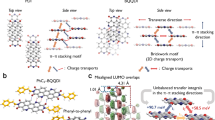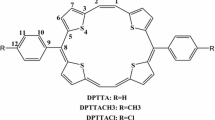Abstract
We designed a series of 5,6,7-trithiapentacene-13-one (TTPO) derivatives (from 1 to 20) by attaching cyano groups (–CN) and by replacing S atoms with Se. The incoherent charge-hopping model combined with the Marcus–Hush electron transfer theory were used to evaluate the charge mobility of the title compounds as potential n-type organic field-effect transistors (OFETs) candidates. Based on the optimized face-to-face dimers, the crystal structures were predicted. The replacement of S with Se can decrease the electron reorganization energy (λ –). The introduction of −CN can decrease the energy levels of both HOMOs and LUMOs, which increases the stability. According to the electronic affinities (EA) and structures of dimers predicted by the DFT method coupled with dispersion corrections (−D), we selected compounds 2, 14, 15, and 19 as initial well-performance OFETs materials and predicted their crystal structures. Based on the optimized crystal structures, the charge (both electron and hole) transport mobilities are estimated. Electron mobilities of 14 and 15 are as high as 2.32 and 2.48 cm2 V−1 s−1, respectively, indicating that 14 and 15 are the promising n-type OFETs materials. What’s more, the predicted crystals show remarkable anisotropic charge mobilities. The maximum electron mobility appears along the direction of face-to-face π-stacking.






Similar content being viewed by others
References
Sun Y, Gu WX, Li YZ, Li YQ, Ma FC (2007) Excited state properties of the p- and n-type semiconductors of thiazolothiazole derivative having thiophene and trifluormethylphenyl rings. Comput Mater Sci 39:376–380
Kwok HL (2005) Modeling current transport in organic light-emitting devices (OLEDs). Comput Mater Sci 33:200–205
Chang L, Jacobs IE, Augustine MP, Moulé AJ (2013) Correlating dilute solvent interactions to morphology and OPV device performance. Org Electron 14:2431–2443
Hatakeyama T, Fukuda K, Okumura H (2013) Physical models for SiC and their application to device simulations of SiC insulated-gate bipolar transistors. IEEE Trans Electron Devices 60:613–621
Ueno K (2010) Fabrication of graphene by chemical methods and its application to organic semiconductor devices. J Phys Soc Jpn 53:73–79
Mesta M, Cottaar J, Coehoorn R, Bobbert PA (2014) Study of charge-carrier relaxation in a disordered organic semiconductor by simulating impedance spectroscopy. Appl Phys Lett 104:213301–213304
Lever L, Kelsall R, Bushby R (2005) A band transport model for highly ordered discotic mesophases. J Comput Electron 1–2:101–104
Wang L, Beljonne D (2013) Flexible surface hopping approach to model the crossover from hopping to band-like transport in organic crystals. J Phys Chem Lett 4:1888–1894
Mccall KL, Rutter SR, Bone EL, Forrest ND, Bissett JS, Jones JDE, Simms MJ, Page AJ, Fisher R, Brown BA, Ogier SD (2014) High performance organic transistors using small molecule semiconductors and high permittivity semiconducting polymers. Adv Funct Mater 24:3067–3074
Kintigh JT, Hodgson JL, Singh A, Pramanik C, Larson AM, Zhou L, Briggs JB, Noll BC, Kheirkhahi E, Pohl K, Mcgruer NE, Miller GP (2014) A robust, high-temperature organic semiconductor. J Phys Chem C 118:26955–26963
Kan J, Chen Y, Qi D, Liu Y, Jiang J (2012) High-performance air-stable ambipolar organic field-effect transistor based on tris(phthalocyaninato) europium(III). Adv Mater 24:1755–1758
Hannewald K, Bobbert PA (2004) Anisotropy effects in phonon-assisted charge-carrier transport in organic molecular crystals. Phys Rev B 69:428–433
Pan JH, Chiu HL, Chen L, Wang BC (2006) Theoretical investigations of triphenylamine derivatives as hole transporting materials in OLEDs: correlation of the Hammett parameter of the substituent to ionization potential, and reorganization energy level. Comput Mater Sci 38:105–112
Xiao X, Meng M, Lei H, Liu CY (2014) Electronic coupling and electron transfer between two dimolybdenum units spaced by a biphenylene group. J Phys Chem C 118:8308–8315
Zhang J, Wang C, Long G, Aratani N, Yamada H, Zhang Q (2016) Fusing N-heteroacene analogues into one “kinked” molecule with slipped two-dimensional ladder-like packing. Chem Sci 7:1309–1313
Shuai Z, Wang L, Song C (2012) Theory of charge transport in carbon electronic materials. Springer briefs in molecular science
Irfana A, Al-Sehemia AG, Muhammad S, Chaudhry AR, Al-Assiri MS, Jin R, Kalam A, Shkir M, Asiri AM (2015) In-depth quantum chemical investigation of electro-optical and charge-transport properties of trans-3-(3,4-dimethoxyphenyl)-2-(4-nitrophenyl)prop-2-enenitrile. CR Chimie 18:1289–1296
Irfan A., Al-Sehemi AG, Muhammad S, Chaudhry AR, Kalam A, Shkir M, AL-Salami AE, Asiri AM (2015) The electro-optical and charge transport study of imidazolidin derivative: quantum chemical investigations. J Saudi Chem Soc 136. doi:10.1016/j.jscs.2014.12.009
Irfan A, Chaudhry AR, Al-Sehemi AG, Al-Asiri MS, Muhammad S, Kalam A (2014) Investigating the effect of acene-fusion and trifluoroacetyl substitution on the electronic and charge transport properties by density functional theory. J Saudi Chem Soc. doi:10.1016/j.jscs.2014.09.009
Chaudhry AR, Ahmed R, Irfan A, Shaari A, Al-Sehemi AG (2014) Effects of electron withdrawing groups on transfer integrals, mobility, electronic and photo-physical properties of naphtho[2,1-b:6,5-b]difuran derivatives: a theoretical study. Sci Adv Mater 6:1727–1739
Norton JE, Brédas JL (2008) Polarization energies in oligoacene semiconductor crystals. J Am Chem Soc 130:12377–12384
Robey SW, Ciszek JW, Tour JM (2007) Effects of substitution on reorganization energies in oligo(-phenylene ethynylene) molecular wires. J Phys Chem C 111:17206–17212
Haghighat AE, Binesh SM (2014) Domain decomposition algorithm for coupling of finite element and boundary element methods. Arab J Sci Eng 39:3489–3497
Nithya R, Senthilkumar K (2014) Theoretical studies on charge transport and optical properties of tris(N-saclicylideneanilines). RSC Adv 4:25969–25982
Sundar VC, Zaumseil J, Podzorov V, Menard E, Willett RL, Someya T, Gershenson ME, Rogers JA (2004) Elastomeric transistor stamps: reversible probing of charge transport in organic crystals. Science 303:1644–1646
Wang X, Lau KC (2012) Theoretical investigations on charge-transfer properties of novel high mobility n-channel organic semiconductors-diazapentacene derivatives. J Phys Chem C 116:22749–22758
Li A, Wen SH, Song JL, Deng WQ (2009) Synthesis of cyanated tetracenes as the organic semiconductors. Org Electron 10:1054–1059
Bangal RP (2007) Density functional studies on the effects of hydrogen bonding on the formation of a charge-transfer complex between p-benzoquinone and 2,6-dimethoxyphenol. J Phys Chem A 111:5536–5543
Fokin AA, Chernish LV, Gunchenko PA, Tikhonchuk EY, Hausmann H, Serafin M, Dahl JEP, Carlson RMK, Schreiner PR (2012) Stable alkanes containing very long carbon-carbon bonds. J Am Chem Soc 134:13641–13650
Zhao CB, Guo YL, Guan L, Ge HG, Yin SW, Wang WL (2014) Theoretical investigation on charge transport parameters of two novel heterotetracenes as ambipolar organic semiconductors. Synth Met 188:146–155
Frisch MJ, Trucks GW, Schlegel HB, Scuseria GE, Robb MA, Cheeseman JR, Scalmani G, Barone V, Mennucci B, Petersson GA, Nakatsuji H, Caricato M, Li X, Hratchian HP, Izmaylov AF, Bloino J, Zheng G, Sonnenberg JL, Hada M, Ehara M, Toyota K, Fukuda R, Hasegawa J, Ishida M, Nakajima T, Honda Y, Kitao O, Nakai H, Vreven T, Montgomery JA Jr, Peralta JE, Ogliaro F, Bearpark M, Heyd JJ, Brothers E, Kudin KN, Staroverov VN, Kobayashi R, Normand J, Raghavachari K, Rendell A, Burant JC, Iyengar SS, Tomasi J, Cossi M, Rega N, Millam JM, Klene M, Knox JE, Cross JB, Bakken V, Adamo C, Jaramillo J, Gomperts R, Stratmann RE, Yazyev O, Austin AJ, Cammi R, Pomelli C, Ochterski JW, Martin RL, Morokuma K, Zakrzewski VG, Voth GA, Salvador P, Dannenberg JJ, Dapprich S, Daniels AD, Farkas O, Foresman JB, Ortiz JV, Cioslowski J, Fox DJ (2009) Gaussian 09, revision A.02. Gaussian Inc., Wallingford
Van Eijck BP, Kroon J (1999) U pack program package for crystal structure prediction: force fields and crystal structure generation for small carbohydrate molecules. J Comput Chem 20:799–812
Panina N, Leusen FJJ, Janssen FFBJ, Verwer P, Meekes H, Vlieg E, Deroover G (2007) Crystal structure prediction of organic pigments: quinacridone as an example. J Appl Crystallogr 40:105–114
Day GM, Chisholm J, Shan N, Motherwell WDS, Jones W (2004) An assessment of lattice energy minimization for the prediction of molecular organic crystal structures. Cryst Growth Des 4:1327–1340
Chaudhry AR, Ahmed R, Irfan A, Shabbir M, Shaari A, Al-Sehemi A (2014) Influence of push-pull configuration on the electro-optical and charge transport properties of novel naphtho-difuran derivatives: a DFT study. RSC Adv 4:48876–48887
Chaudhry AR, Ahmed R, Irfan A, Shaari A, Matisa AR, Muhammad S, Al-Sehemi Abdullah G (2015) Effect of donor strength of extended alkyl auxiliary groups on optoelectronic and charge transport properties of novel Naphtha[2,1-b:6,5-b′]difuran derivatives: simple yet effective strategy. J Mol Model 21:1–16
Gdanitz RJ (1992) Prediction of molecular crystal structures by Monte Carlo simulated annealing without reference to diffraction data. Chem Phys Lett 190:391–396
Chang YF, Lu ZY, An LJ, Zhang JP (2012) From molecules to materials: molecular and Crystal engineering design of organic optoelectronic functional materials for high carrier mobility. J Phys Chem C 116:1195–1199
Briseno AL, Mao Q, Ling MM, Colin R, Meng H, Bao ZN, Wudl F (2006) Hexathiapentacene: structure, molecular packing, and thin-film transistors. J Am Chem Soc 128:15576–15577
Chen XK, Guo JF, Zou LY, Ren AM, Fan JX (2011) A promising approach to obtain excellent n-type organic field-effect transistors: introducing pyrazine ring. J Phys Chem C 115:21416–21428
Lee C, Sohlberg K (2010) The effect of substitution on reorganization energy and charge mobility in metal free phthalocyanine. Chem Phys 367:7–19
Wan A, Hwang J, Amy F, Kahn A (2005) Impact of electrode contamination on the α-NPD/Au hole injection barrier. Org Electron 6:47–54
Zhang SF, Chen XK, Fan JX, Ren AM (2013) Charge transport properties in a series of five-ring-fused thienoacenes: a quantum chemistry and molecular mechanic study. Org Electron 14:607–620
Wen Y, Liu Y (2010) Recent progress in n-channel organic thin-film transistors. Adv Mater 22:1331–1345
Chang YC, Kuo MY, Chen CP, Lu HF, Chao I (2010) On the air stability of N-channel organic field-effect transistors: a theoretical study of adiabatic electron affinities of organic semiconductors. J Phys Chem C 114:11595–11601
Coropceanu V, Cornil J, Filho DADS, Olivier Y, Silbey R, Bredas JL (2007) Charge transport in organic semiconductors. Chem Rev 107:926–952
Zhao CB, Ge HG, Yin SW, Wang WL (2014) Theoretical investigation on the crystal structures and electron transport properties of several nitrogen-rich pentacene derivatives. J Mol Model 20:2158
Kenji K, Reishi S, Masatoshi K, Masamichi Y, Kentaro Y (2006) Synthesis and cofacial π-stacked packing arrangement of 6,13-bis(alkylthio)pentacene. Org Lett 8:2385–2388
Yang XD, Wang LJ, Wang CL, Long W, Shuai ZG (2008) Influences of crystal structures and molecular sizes on the charge mobility of organic semiconductors: oligothiophenes. Chem Mater 20:3205–3211
Yin J, Chaitanya K, Ju XH (2015) Structures and charge transport properties of “selenosulflower” and its selenium analogue “selflower”: computer-aided design of high-performance ambipolar organic semiconductors. J Mater Chem C 3:3472–3481
Anthony EJ (2006) Functionalized acenes and heteroacenes for organic electronics. Chem Rev 106:5028–5048
Acknowledgements
The authors thank the National Science Foundation of China (No. 21372116), the Project Funded by China Postdoctoral Science Foundation (No. 2015M581082) as well as the Project Funded by the Priority Academic Program Development of Jiangsu Higher Education Institutions (PAPD) for supporting this work.
Author information
Authors and Affiliations
Corresponding author
Electronic supplementary material
Below is the link to the electronic supplementary material.
Rights and permissions
About this article
Cite this article
Hu, Y., Chaitanya, K., Yin, J. et al. Theoretical investigation on the crystal structures and electron transfer properties of cyanated TTPO and their selenium analogs. J Mater Sci 51, 6235–6248 (2016). https://doi.org/10.1007/s10853-016-9921-8
Received:
Accepted:
Published:
Issue Date:
DOI: https://doi.org/10.1007/s10853-016-9921-8




